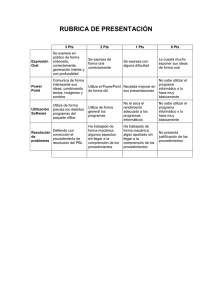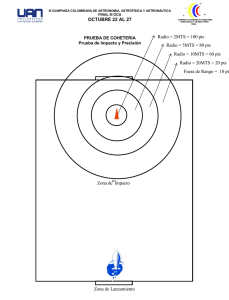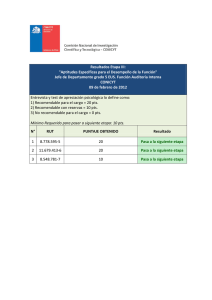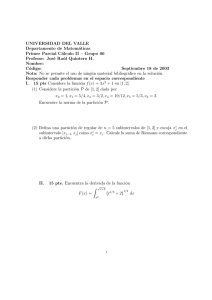OCLUSIÓ DE COLON: CIRURGIA PRIMÀRIA VS STENT Cirugía
Anuncio
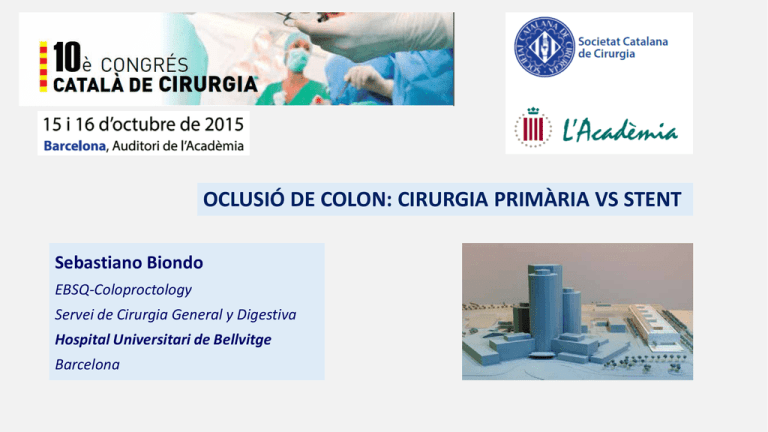
OCLUSIÓ DE COLON: CIRURGIA PRIMÀRIA VS STENT Sebastiano Biondo EBSQ-Coloproctology Servei de Cirurgia General y Digestiva Hospital Universitari de Bellvitge Barcelona 361 patients colonic cancers 86 (23.8%) complicated Cancer related survival and recurrence in patients with complicated colonic cancers may improve, moving towards that of elective surgery, if a 45 (76.3%) obstruction surgical treatment with radical oncological criteria 27 (31.4%) palliative surgery is performed. OCLUSIÓ DE COLON: CIRURGIA PRIMÀRIA VS STENT Cirugía urgente vs cirugía electiva Altos índices de morbilidad, mortalidad, estomas Breitenstein S, et al. Br J Surg 2007 Tan CJ, et al. Br J Surg 2012 Huang X, et al. J Gastroint Surg 2014 Colocación de Stent Cirugía urgente en electiva Tratamiento definitivo o puente a la cirugía Varios estudios no han podido demostrar mejores resultados en el Tto con prótesis Tan CJ, et al. Br J Surg 2012 Sagar J. Cochrane Syst rev 2011 Van Hooft JE, et al Lancet Onco 2011 ALGORITMO TERAPÉUTICO TUMOR COMPLICADO RESECABLE IRRESECABLE grave deterioro estado general Lesión Proximal Tumor sincrónico PRÓTESIS BYPASS RESECC. LIMITADA COLOSTOMÍA COLECTOMÍA HEMICOLECTOMÍA SUBTOTAL IZQUIERDA Dis Colon Rectum 2004;47:1889–97 Dis Colon Rectum 2004;47:1889–97 Dis Colon Rectum 2005; 48: 2272–2280 No se observaron diferencias entre pacientes con oclusión y perforación Dis Colon Rectum 2005; 48: 2272–2280 The overall mortality was 6.2 % (13 patients) Colorectal Dis. 2011;13:e116-22 Colorectal Dis. 2011;13:e116-22 Dehiscencia anastomótica Resección distal Resección proximal 8,9% 21% 6,3% 5,8% P =0,007 Cirujano General Cirujano Colorrectal Urgencias colorrectales Prótesis colónica. Colocación n Ventajas n Procedimiento “no quirúrgico” n Conversión cirugía urgente ®cirugía electiva n Menor mortalidad n “Evita” el porcentaje de estomas Itabashi M. Dis Colon Rectum 1993 Tejero E. Dis Colon Rectum 1994 n Inconvenientes n Posibilidad de perforación n ¿”Seguridad oncológica” ? Complicaciones • Hemorragia • Dolor y tenesmo: inferior a 5 cm • Impactación fecal • Incontinencia • Bacteriemia y fiebre • Otras Migración: 3%-12% Re-oclusión: 1%-92% (media 12%) Perforación: 5%-16% OCLUSIÓN PROXIMAL Nivel de evidencia bajo Grado de recomendación débil Grading of recommendations Assessment, Development and Evaluation system (GRADE) Takuma A. et al. Surg Laparosc Endosc Percutan Tech 2014 49 pts stent: Éxito en 35 pts (71.4%) (9 re-stent) + 11 pts (22%) op. 6 pts peritonitis IQ directa Mortalidad in 2 pts (6.1%) (stent) It may be wise to considered stenting as part of the therapeutic armamentarium available to treat some patients and some phases of disease after an individualized evaluation. We have observed how morbidity and failure of a less aggressive treatment, as stent has been claimed to be, is not negligible. Stent : 4.4 (3.7-32.2) meses Cirugía: 23.7 (0.2-32.0) meses van Hooft et al, Endoscopy 2008 1,816 pts: 1,485 pts (81.8%) acute resection 196 pts (10.8%) endoscopic stent followed by resection 135 pts (7.4%) decompressing stoma followed by resection Use of endoscopic stenting: 18% (2009) - 6% (2012) 30-day or in-hospital mortality rate: Resection 6.9%; Stent 5.6%; Stoma 3.7% Mortality rate after acute resection was 2.9% in patients >70 years, but mortality rates up to 32.2% were observed in high-risk elderly patients. Acute resection as first choice treatment seems justified for patients >70 years of age given a mortality rate of 3%. For the elderly frail patients, mortality rates over 30% after acute resection stress the need for alternative treatment strategies. LOCAL RECURRENCE Total ≤ 75 years SEMS “bridge to surgery” 23 % 32 % Emergency surgery 15 % 8% 48 pts Stent 39 pts Surgery Sabbagh C. et al. Surg Endosc 2013 CONCLUSIONS: Colorectal stenting as a bridge to surgery showed no significant short- or long-term benefits compared with surgery only, and was associated with peritoneal seeding after perforation. Stenting before surgery should therefore only be considered in patients with a high risk of complications associated with emergency surgery. CONCLUSION: This randomized trial failed to demonstrate that emergency preoperative SEMS for patients presenting with acute leftsided malignant colonic obstruction could significantly decrease the need for stoma placement. INTERPRETATION: Colonic stenting has no decisive clinical advantages to emergency surgery. It could be used as an alternative treatment in as yet undefined subsets of patients, although with caution because of concerns about tumour spread caused by perforations. Dis Colon Rectum. 2015;58:358-62 126 consecutive pts: stent for colonic obstruction 108 pts (86%) technical success 89 pts (70%) decompression Successful deployment and clinical decompression: colorectal cancer (p = 0.03) shorter strictures (p = 0.01) wider angulation distal to the obstruction (p = 0.049) Perforation was associated with longer strictures (p = 0.03) RECOMENDACIONES STENTS Surgical resection is suggested as the preferred treatment for malignant obstruction of the proximal colon in patients with potentially curable disease (weak recommendation, low quality evidence). In a palliative setting, SEMS can be an alternative to emergency surgery (weak recom- mendation, low quality evidence). Colonic SEMS placement as a bridge to elective surgery is not recommended as a standard treatment of symptomatic left-sided malignant colonic obstruction (strong recommendation, high quality evi-dence). For patients with potentially curable left-sided obstructing colonic cancer, stent placement may be considered as an alternative to emergency surgery in those who have an increased risk of postop-erative mortality. i.e. ASA ≥ III and/or age ≥ 70 years (weak recommendation, low quality evidence) ESGE Clinical Guideline. Gastrointestinal Endoscopy 2014;80(5):747-75 doi:10.1016/j.gie.2014.09.018 CONCLUSIONES • La cirugía urgente por neoplasia complicada de colon se asocia a elevada morbimortalidad. La resección con anastomosis primaria (+ ileostomía) debería ser el objetivo principal en pacientes seleccionados y realizada por cirujanos con especial dedicación a la cirugía colorrectal y urgente. • En nuestra experiencia, la especialización en cirugía colorrectal influye en los resultados postoperatorios. Especial incidencia en el tratamiento del cáncer oclusivo del colon proximal. • La colocación de un stent como parte del arsenal terapéutico disponible para el tratamiento de pacientes con CCR ocluido y en algunas fases de la enfermedad, es una alternativa válida tras una evaluación individualizada de los pacientes. • Los pacientes paliativos con buen estado general y sin enfermedad neoplásica localmente avanzada, quizás podrían beneficiarse de una resección paliativa de urgencia del tumor primario obstructivo.

